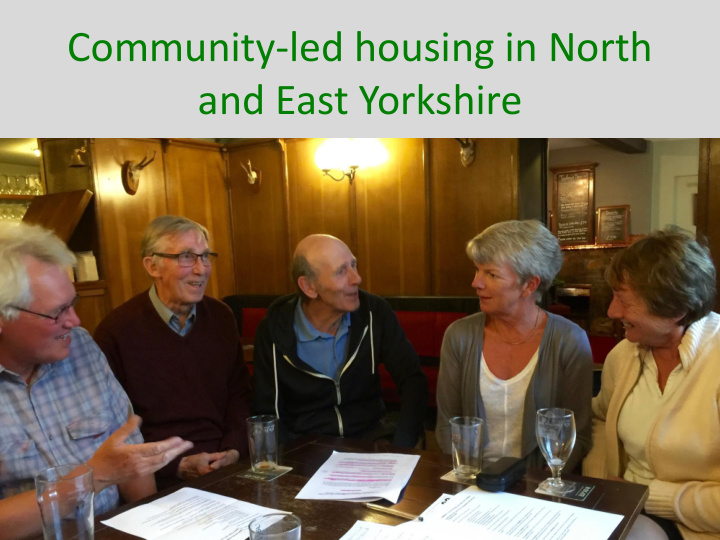



Community-led housing in North and East Yorkshire
What is community-led housing? Community-led housing schemes have six main features: They put local communities in the driving seat . You decide where homes are built, what they look like and who occupies them; you create community assets which can generate income for your town or village which can be used to support other local priorities They are usually small scale – most developments are less than 10 homes and some are much smaller. No two developments are the same. Although most schemes are usually set up and run by local people in their own communities , many are also supported by housing associations, local authorities or regional and national organisations
What is community-led housing? They provide genuinely affordable homes for rent, shared ownership, sale or self-build on sites that are often difficult or even impossible for mainstream housing providers to develop Schemes meet long-term local housing needs , by the community exercising full control over how and where the homes are provided and retaining a legal and/or financial interest in them, ensuring they will always be available to local people who need them and at a price they can afford Community-led housing is not for profit, involving considerable voluntary effort from those who decide to become involved. It’s an effort that several hundred communities across the country have already made, with many successful developments initiated by Parish Councils
The national picture Community- led housing represents less than 1% of the nation’s housing stock 170 community land trusts, aiming for 3000 homes across England by 2020 1000 housing co-operatives with 200,000 homes in management 54 cohousing schemes 130 tenant management organisations 100-150 homes a year provided through community self-build
Community-led housing in action
Why community-led housing in North Yorkshire and East Riding?
Why community-led housing in North York Moors National Park? Second home owners are increasingly reducing the supply of affordable homes in many villages, at a time when demand for them is increasing Many homes are now unaffordable by local people who may need to work in the community, downsize or rely on family support, but are forced to live elsewhere Any new development in the National Park is sensitive and needs to fit closely with community needs and aspirations; when communities take the lead, the outcomes are almost always positive In villages where local services are under threat, a community-led housing scheme can kick start other initiatives to keep essential services going, some of them through community ownership
Sources of support Money Getting started: Locality and Community Land Trust Network grants Subsidy: Rural and Coastal Communities Fund; Homes and Communities Agency; local authorities Loans: Banks, building societies, social investment funds and community bonds External support National Park: Planning policies Rural Housing Enablers: Helping identify sites; housing need surveys; coordination Housing associations: Partnering with communities; acting as a developer; securing funding Independent networks: On the ground support; training; ‘seeing is believing’
The Rural and Coastal Community Led Housing Fund £300 million DCLG programme over 5 years, starting in 2016/17 Announced in Chancellor’s March 2016 budget, with income generated from increased stamp duty on buy-to-let landlords Details still to be announced, following Government changes in July; now expected in October A key role for local housing authorities, with significant funding allocations in 2016/17 Initial focus likely to be on villages and small towns with a high % of second home ownership Expected emphasis on low cost home ownership, but will be some affordable rent in the mix Possible raised subsidy levels in some high value locations to reflect higher development costs Some revenue funding for pump-priming schemes and providing external support likely
Parish Council survey
Potential community-led housing schemes
Discussion points o Which Parishes have a possible interest in looking at community-led housing in more detail? o What role might Parish Councils play in promoting and supporting community-led schemes in their own villages? o What support could the National Park Authority provide for villages/parishes that may be interested? o Will landowners be more willing to offer sites for housing development if they are led by the local community? o Who will provide the technical and on-the-ground support for local communities interested in developing their own housing schemes?
Recommend
More recommend